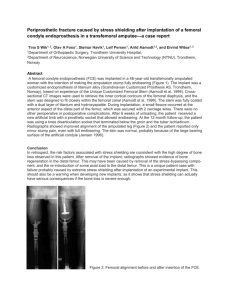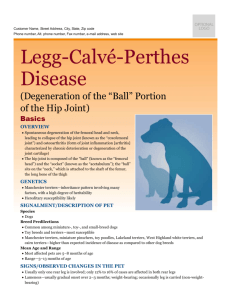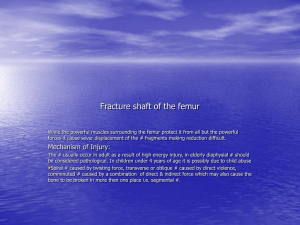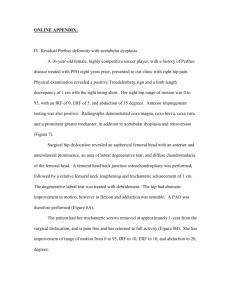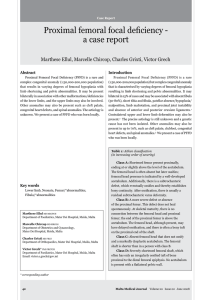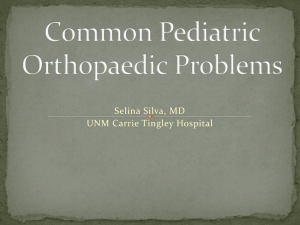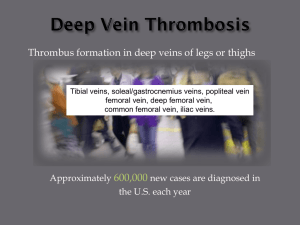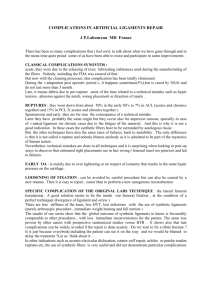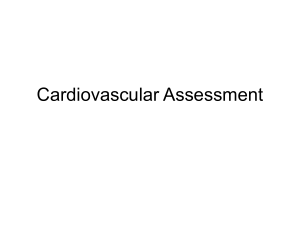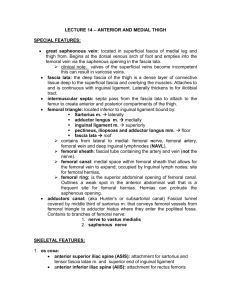Patterson, Francis R., MD
advertisement
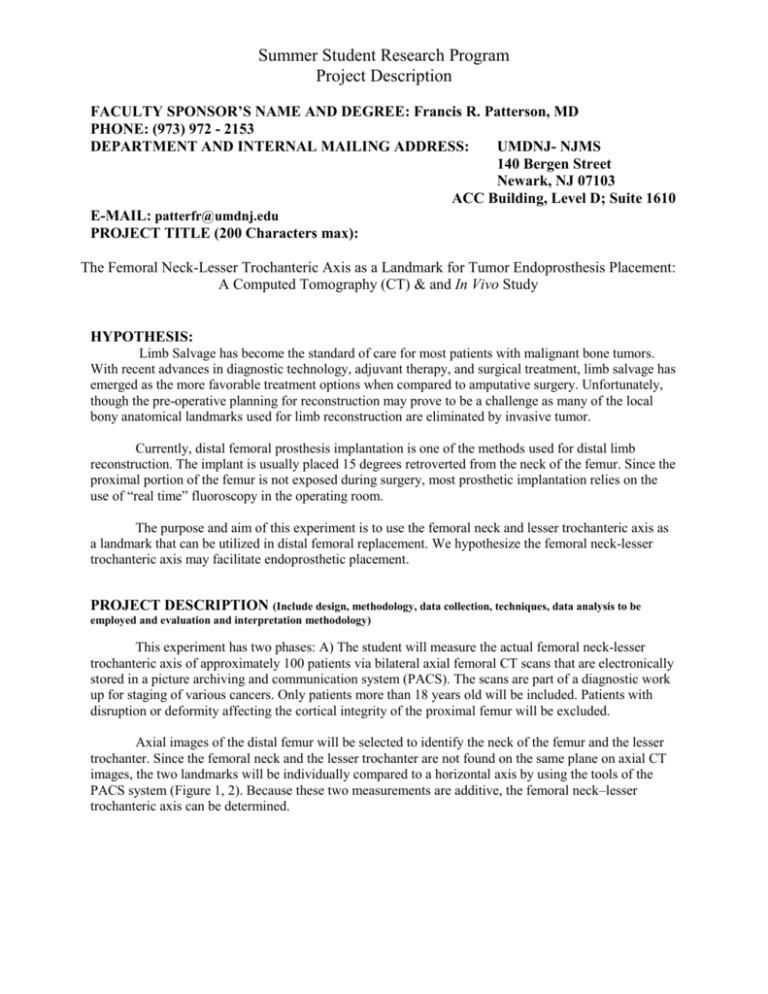
Summer Student Research Program Project Description FACULTY SPONSOR’S NAME AND DEGREE: Francis R. Patterson, MD PHONE: (973) 972 - 2153 DEPARTMENT AND INTERNAL MAILING ADDRESS: UMDNJ- NJMS 140 Bergen Street Newark, NJ 07103 ACC Building, Level D; Suite 1610 E-MAIL: patterfr@umdnj.edu PROJECT TITLE (200 Characters max): The Femoral Neck-Lesser Trochanteric Axis as a Landmark for Tumor Endoprosthesis Placement: A Computed Tomography (CT) & and In Vivo Study HYPOTHESIS: Limb Salvage has become the standard of care for most patients with malignant bone tumors. With recent advances in diagnostic technology, adjuvant therapy, and surgical treatment, limb salvage has emerged as the more favorable treatment options when compared to amputative surgery. Unfortunately, though the pre-operative planning for reconstruction may prove to be a challenge as many of the local bony anatomical landmarks used for limb reconstruction are eliminated by invasive tumor. Currently, distal femoral prosthesis implantation is one of the methods used for distal limb reconstruction. The implant is usually placed 15 degrees retroverted from the neck of the femur. Since the proximal portion of the femur is not exposed during surgery, most prosthetic implantation relies on the use of “real time” fluoroscopy in the operating room. The purpose and aim of this experiment is to use the femoral neck and lesser trochanteric axis as a landmark that can be utilized in distal femoral replacement. We hypothesize the femoral neck-lesser trochanteric axis may facilitate endoprosthetic placement. PROJECT DESCRIPTION (Include design, methodology, data collection, techniques, data analysis to be employed and evaluation and interpretation methodology) This experiment has two phases: A) The student will measure the actual femoral neck-lesser trochanteric axis of approximately 100 patients via bilateral axial femoral CT scans that are electronically stored in a picture archiving and communication system (PACS). The scans are part of a diagnostic work up for staging of various cancers. Only patients more than 18 years old will be included. Patients with disruption or deformity affecting the cortical integrity of the proximal femur will be excluded. Axial images of the distal femur will be selected to identify the neck of the femur and the lesser trochanter. Since the femoral neck and the lesser trochanter are not found on the same plane on axial CT images, the two landmarks will be individually compared to a horizontal axis by using the tools of the PACS system (Figure 1, 2). Because these two measurements are additive, the femoral neck–lesser trochanteric axis can be determined. Summer Student Research Program Project Description Figure 1 Figure 2 B) The second phase the experiment entails in vivo evaluation of the same axis in the laboratory. Fifteen (15) paired proximal femur specimens will be used to measure the femoral neck-lesser trochanteric axis. Then using femoral version under direct fluoroscopy (“real time image”), the measured axis will be translated distally onto the osteotomized bone. This will be accomplished by rotating the specimen under fluoroscopic view until the lesser trochanter is at maximal view on the fluoroscopic monitor. Using a marking pen, this alignment will be noted by a distal mark made on the cortex of the osteomized bone at a designated fulcrum. Then, the translated experimental angular position of the femoral neck will also be noted and marked via goniometer. ` A distal femoral endoprosthesis will then be positioned and retroverted 15 degrees from the mark indicating proper implant position. The experimental implant position will be confirmed via goniometer and its relationship to the actual femoral neck will be noted. Actual and experimental femoral neck-lesser trochanteric axis measurements will be compared. Paired analysis using the non-parametric Wilcoxon signed-rank test will be used to determine the mean femoral neck and lesser trochanteric angle and 95% confidence intervals (CI) for each image and/or specimen and results compared. SPONSOR’S MOST RECENT PUBLICATIONS RELEVANT TO THIS RESEARCH: Patterson FR, Tuy B, Loree R, Beebe KS, Sirkin MS, Benevenia J. The Linea Aspera as a Rotational landmark in Tumor Endoprosthesis: A Computed Tomography (CT)Study. Poster and podium Presentation, 14th International Symposium on Limb Salvage, September 14, 2007, Hamberg, germany. IS THIS PROJECT SUPPORTED BY EXTRAMURAL FUNDS? Yes or No (IF YES, PLEASE SUPPLY THE GRANTING AGENCY’S NAME) THIS PROJECT IS: Clinical THIS PROJECT IS CANCER-RELATED Laboratory Behavioral Other Summer Student Research Program Project Description THIS PROJECT IS HEART, LUNG & BLOOD- RELATED THIS PROJECT EMPLOYS RADIOISOTOPES THIS PROJECT INVOLVES THE USE OF ANIMALS PENDING APPROVED IACUC PROTOCOL # THIS PROJECT INVOLVES THE USE OF HUMAN SUBJECTS PENDING APPROVED THIS PROJECT IS SUITABLE FOR: UNDERGRADUATE STUDENTS SOPHMORES IRB PROTOCOL # M ENTERING FRESHMAN ALL STUDENTS WHAT WILL THE STUDENT LEARN FROM THIS EXPERIENCE? The student applicant should have a strong interest in pursuing orthopaedic surgery as a future career path, as this project entails an understanding of the basic techniques of landmark orientation for conventional distal femoral replacements. The student will learn how to measure the angular axis of bony landmarks off diagnostic CT scans that are stored electronically in our PACS system. . They will also gain the experience of carrying out the above hypothesis and scientific method to be presented for a poster and future publication. Above all, the student will learn or reinforce their knowledge of bone anatomy and bone tumor pathology under the guidance of musculoskeletal oncologists.
